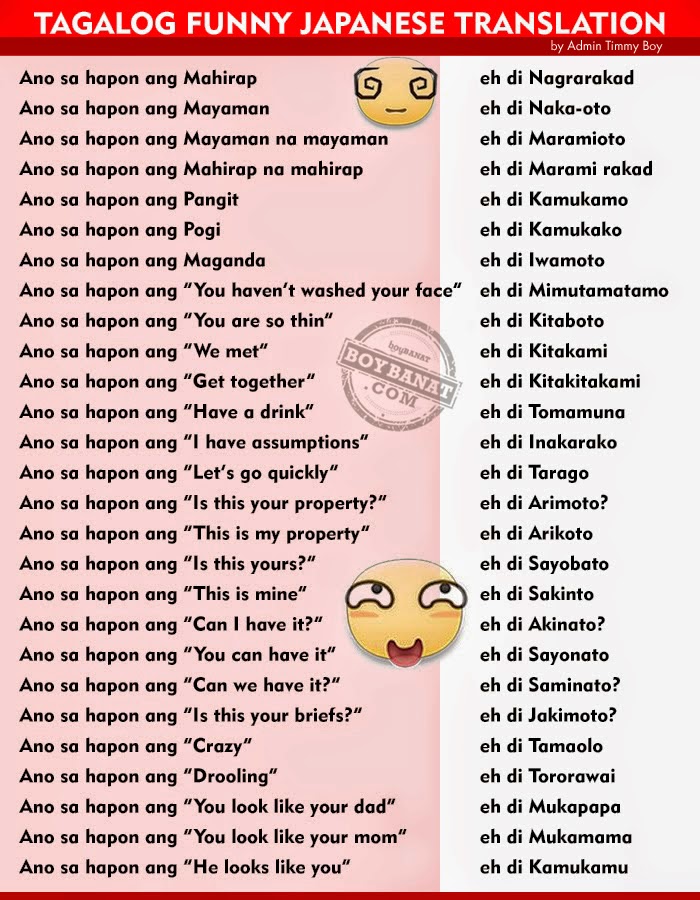

Most Filipinos often refer to regional languages of the Philippines as different dialects. If you try speaking Tagalog to Filipinos in Visayas or Mindanao, most of them won’t understand specific vocabulary.Īlthough some Filipino dialects and languages are mutually understandable, the language families that the dialects and languages came from are different.Ī dialect is a form of language specific to a region or a social group. However, Tagalog is famous in the northern part of the country (Luzon). The majority of Filipinos understand Tagalog as that’s the most spoken language in the Philippines. As a result, 184 living languages (data from Ethnologue) originate from the Philippines with fluent native speakers. It is also known as the business language since English is a widely spoken language in Southeast Asia.Īre Filipino Languages And Filipino Dialects Different?įilipino languages came from the Austronesian language family and the Malayo-Polynesian language family. Modern Times Mean A Change In Business Language (2003)Įnglish was strengthened as a medium of teaching in the Philippines alongside Pilipino. It is the most widely spoken language among the younger Filipino generation. Filipino is now the official national language of the Philippines, derived from the Tagalog language. The letter P from Pilipino was changed to F by the Philippine Government. From P To F: How Pilipino Became Filipino (1976 Until Present) Public education highlighted the importance of using Pilipino in schools and government offices. Pilipino became the national language of the Philippines. The Japanese encouraged the spread of the Tagalog language in schools and work and still was the national language of the Philippines. The Japanese language was introduced but wasn’t widely spoken. In 1937: Tagalog became the official language of the Philippines, spearheaded by Manuel L. The Philippines had a transitional government ruled by the Filipinos after the American and Spanish occupation. Philippine Commonwealth Period (1898-1935) It was introduced in public schools, government offices, and even for the commonfolk. American Period (1898-1935)Įnglish became the official language of the Philippines. Other ethnic groups in the Philippines and regional languages immerged. Spanish became the national language, but only the illustrados (educated) could learn it. Spanish colonized the Philippines and removed all previous cultures and languages through Christian indoctrination. Languages present were Baybayin (the native language of the pre-colonial Filipinos), Chinese and Arabic (due to trade), and other Austronesian and Malayo-Polynesian language families. Philippine Languages Timeline In Summary Pre-Colonial Period We’ll have to dive deeper into the history of existing Philippine languages and clarify misconceptions about the differences between a dialect and a language. It is the native language of 82 million people locally and worldwide. Why are there so many languages and dialects in the Philippines? Are they all closely related? There are many Filipino dialects, and you’ll be surprised that most of them are not just a dialect but are major languages of their own.įilipino is the official language of the Philippines. If you want to learn at least one of them (Tagalog), we recommend you start your journey by reading more about the Philippine languages’ history. Despite the diversified changes, almost all languages spoken in the Philippines have a vast number of native speakers.Īt least eight major languages are spoken in the Philippines, found in Luzon, Visayas, and Mindanao. Every historical period influenced a shift in vernaculars and loanwords up to the official language and alphabet of the Philippines. The Filipino language came from a long timeline of cultural, religious, and political changes.

As an archipelago, you’ll even find sub-languages and sub-dialects on what is already a large umbrella of jargon and vocabulary. Let’s take a closer look at how the Filipino language evolved from these dialects.Įver wonder why Tagalog is the most used indigenous language spoken in the Philippines, but the national language is called Filipino? It’s easy to say that the Philippines has numerous languages due to its shape and geographical structure. Today, at least 170 Filipino dialects are spoken in different regions. These are just some of the existing native languages in the Philippines. Which following dialects do you know? Hiligaynon, Cebuano, Tagalog, and Tausug.


 0 kommentar(er)
0 kommentar(er)
